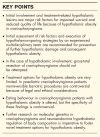Craniopharyngioma and hypothalamic injury: latest insights into consequent eating disorders and obesity
- PMID: 26574645
- PMCID: PMC4700877
- DOI: 10.1097/MED.0000000000000214
Craniopharyngioma and hypothalamic injury: latest insights into consequent eating disorders and obesity
Abstract
Purpose of review: Hypothalamic alterations, pathological or treatment induced, have major impact on prognosis in craniopharyngioma patients mainly because of consequent hypothalamic obesity. Recent insight in molecular genetics, treatment strategies, risk factors and outcomes associated with hypothalamic obesity provide novel therapeutic perspectives. This review includes relevant publications since 2013.
Recent findings: Recent findings confirm that alterations in posterior hypothalamic areas because of tumour location and/or treatment-related injuries are associated with severe hypothalamic obesity, reduced overall survival and impaired quality of life in long-term survivors of childhood-onset craniopharyngioma. However, eating disorders are observed because of hypothalamic obesity without clear disease-specific patterns. Treatment options for hypothalamic obesity are very limited. Treatment with invasive, nonreversible bariatric methods such as Roux-en-Y gastric bypass is most efficient in weight reduction, but controversial in the paediatric population because of medical, ethical, and legal considerations. Accordingly, treatment in craniopharyngioma should focus on prevention of (further) hypothalamic injury. Presurgical imaging for grading of hypothalamic involvement should be the basis for hypothalamus-sparing strategies conducted by experienced multidisciplinary teams.
Summary: Until a nonsurgical therapeutic option for hypothalamic obesity for paediatric patients is found, prevention of hypothalamic injury should be the preferred treatment strategy, conducted exclusively by experienced multidisciplinary teams.
References
-
- Haliloglu B, Bereket A. Hypothalamic obesity in children: pathophysiology to clinical management. J Pediatr Endocrinol Metab 2015; 28:503–513. - PubMed
-
A comprehensive review on the hypothalamic obesity in pediatric patients.
-
- Bereket A, Kiess W, Lustig RH. Kiess W, Wabitsch M, Maffeis C, Sharma AM, et al. Hypothalamic obesity in children. Metabolic syndrome and obesity in childhood and adolescence 1st ed.Basel, Switzerland: Karger; 2015; 19:13–30.
-
- Müller HL. Evans JJ, Kenning TJ. Craniopharyngioma: pediatric management. Craniopharyngiomas: comprehensive diagnosis, treatment and outcome 1st edMunich, Germany: Elsevier; 2015. 429–458.
Publication types
MeSH terms
LinkOut - more resources
Full Text Sources
Other Literature Sources
Medical
Research Materials


